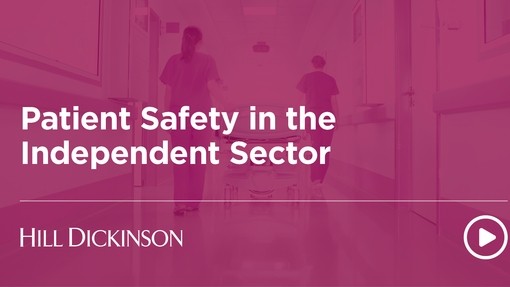Procuring healthcare services – the Provider Selection Regime – where are we now and what will it mean for the independent sector?

Details
Linked to and enabled by NHS reforms contained within the Health and Care Act 2022, the government plans to replace current rules for procurement of healthcare services with a new ‘provider selection regime’ later this year. While consultations have been under way on the new regime for some time, the most recent development in this area is the release of a new consultation by the Department of Health and Social Care considering some of the detail of the regulations underpinning the new regime.
The overarching aim is to move away from the expectation of competition in all circumstances. Rather, the plan is to encourage flexibility to promote the interests of patients, taxpayers and the population, and remove barriers to integration and collaboration. While this shift is likely to be welcomed by many involved in arranging healthcare services as making it more straightforward to continue with arrangements which are working well, independent healthcare providers either currently supplying, or planning to bid for, NHS healthcare contracts, do need to be prepared for the changes to ensure they are well positioned to be appointed either to continue in their current arrangements or afresh when a selection process is run.
The proposals present some risk for independent sector providers, but also opportunity, as we explain below.
When will the new regime apply?
The new regime is intended to apply to health services, as defined in the NHS Act 2006, which provide directly for individuals or have an outcome directly for individuals. The new regime will exclude ‘healthcare adjacent’ services, for example hospital catering or cleaning contracts. It will apply where services are being arranged by a ‘decision-making body’ to include NHS England or Integrated Care Boards, local or combined authorities arranging healthcare services as part of their public health functions or as part of section 75 arrangements with the NHS, or NHS trusts / foundation trusts, arranging the provision of healthcare services by other providers.
Following feedback on the original proposals, the DHSC consultation also proposes that the new regime be applied in certain ‘mixed procurement’ scenarios, namely:
- where the primary aim is to deliver a healthcare service, but a single contract may be awarded which also includes additional elements, and procuring the elements separately under separate regimes would not be in the best interests of patients, taxpayers and the population - an example is a vaccination service which requires a substantial administrative input; and
- while social care services are excluded on a standalone basis, they may be included in certain scenarios where excluding them would prove a barrier to increased integration and collaboration – examples listed in the Consultation include provision of NHS Continuing Healthcare, BCF packages, discharge to assess, mental health aftercare and prison healthcare.
Procurement of goods and pharmaceuticals is excluded.
How will the new regime operate?
The regime is intended to be applied when healthcare services are being arranged for the first time, coming to an end or changing considerably. In these circumstances a procurement decision will need to be made in one of three key scenarios, which the proposals refer to as ‘decision-making circumstances’ namely:
- Existing arrangements are to continue because – (1A) the incumbent is the only viable provider due to the nature of the particular services; (1B) a range of accredited providers are already available to patients through patient choice routes; or (1C) the incumbent is doing a good job and the service is not changing.
- A new most suitable provider is needed for new or considerably changed arrangements – for example where the incumbent no longer wants to continue the service, or where the decision-making body wants to use a different provider which it can identify without a competitive process.
- Competitive procurement is required – this may be because a single provider cannot be identified without a competitive process or the decision-making body wants to test the market.
In scenarios 1A and 1B there is no selection between providers involved, such that under the proposals the decision-making body need only record its decision-making process and rationale internally, and publish a contract award notice to ensure transparency.
In scenarios 1C, 2, and 3, the decision-making body would need to consider a set of defined ‘key criteria’ to decide whether to either make an award or to run a competitive process. Further steps would also be required to ensure transparency, dependent on the scenario, including actions such as:
- Publishing details of the intended approach in advance
- Publishing a notice for competitive tender
- Recording the decision-making process and rationale internally
- Responding to unsuccessful bidders
- Publishing an intention to award notice
- Standstill / resolution periods
- Publishing the award confirmation
Key criteria
Bearing in mind the details of the proposed regime set out above, the key criteria are a focus area for independent healthcare sector providers to consider and position themselves most advantageously to either retain existing contracts or be appointed to new ones. While the full details of those criteria will not be confirmed until the final regulations are published, the following have been set out in the proposals to date:
- Quality and innovation – maximising service quality and expecting providers to innovate and improve services, and proactively develop services that are fit for the future;
- Value – involves selecting an option which provides the best combination of benefits to individuals in terms of outcomes, to the population in terms of improved health and wellbeing, and value for the taxpayer by reducing the burden of ill health;
- Integration, collaboration, service sustainability – maximising service integration to improve patient outcomes, ensuring that decisions about services support their long-term sustainability, and ensuring that decisions are consistent with local and national plans around integrating care / joining up services;
- Access, inequalities, disparities, and choice – maximising choices available to patients, ensuring that services and treatments are accessible and a particular focus on tackling health inequalities and disparities; and
- Social value – maximising social value created by arrangements being made, including alignment with guidance on social value published by the Cabinet Office and NHS England.
Implications for the sector
Independent sector providers could understandably feel concern at the imposition of a new regime which reduces the frequency of competitive tendering processes, limiting the opportunity to bid to provide healthcare services to the NHS. This scenario does present risk, however there is opportunity too in terms of high-performing providers being reappointed in existing arrangements without needing to go through a tender process against either other independent sector or public sector providers and potentially being appointed to new arrangements without a competitive process.
Maintaining a clear understanding of the key criteria and being able to evidence how proposed and existing arrangements support these will be crucial to taking best advantage of the new regime. Independent sector providers may, in particular, be well positioned to deliver innovative solutions, which is flagged within those criteria.
This article was first published in Healthcare Markets Magazine.






